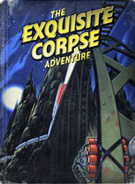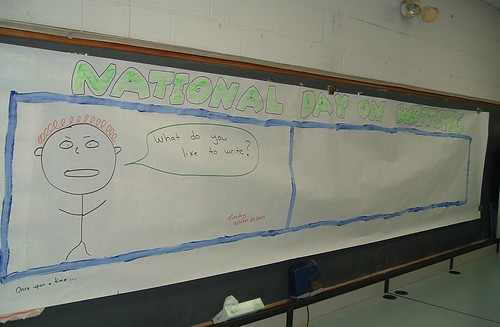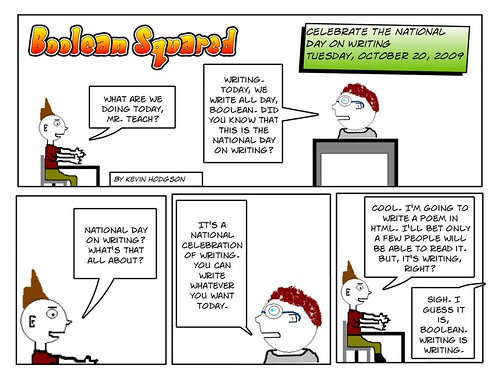I write with my students all the time. Sometimes, I pull up to an empty desk and plop myself down and just write. And I share what I write. Not just what I write, but I talk through my writing process — about what I stumbled on, where my idea came from and what I would do if I were to revise my writing. My goal is to make my writing process transparent to my students.
 As an example, we are following the development of a story called The Exquisite Corpse, which was started by Jon Scieszka and every two weeks for the next year, another published author is adding a chapter to this funny, bizarre adventure story (this week, Katherine Patterson added a chapter). Scieska put forth a whole bunch of strange characters that must be included before the the story ends. Here is what Scieszka writes:
As an example, we are following the development of a story called The Exquisite Corpse, which was started by Jon Scieszka and every two weeks for the next year, another published author is adding a chapter to this funny, bizarre adventure story (this week, Katherine Patterson added a chapter). Scieska put forth a whole bunch of strange characters that must be included before the the story ends. Here is what Scieszka writes:
If the train makes it over the last treacherous gorge, there is a good chance that you and Nancy and Joe will have to deal with werewolves and mad scientists, real ninjas and fake vampires, one roller-skating baby, a talking pig, creatures from another planet (possibly another dimension), killer poetry, clues from classic children’s books, two easy riddles, several bad knock knock jokes, plenty of explosions, a monkey disguised as a pirate, two meatballs, a blue plastic Star Wars lunch box (missing its matching thermos), three ticking clocks, and not just one bad guy – but a whole army of villains, cads, scalawags, sneaks, rats, varmints and swindlers. Also several desperados, a gang of evildoers, and one just plain bad egg.
We’re using these chapters as inspiration for our own version of the next chapters, and then comparing what the published writer did compared to what we did. It’s been great fun already.
The other day, this is what I wrote after Katherine Patterson left us dangling with a cliffhanger, in which a shadowy figure approaches the two main characters, who have just tightrope walked across the mangled remains of an exploded train bridge. This is where I picked up the story:
The voice struck a nerve with the twins. Like Boppo the mad clown, the Pirate King was like some bad memory that they had tried to forget, but could not. And here he was, standing before them with his sword in one hand and his feather-plume hat flapping in the wind like a bird’s wings.
“You two kids are not easy to track, but thanks to my spies, I found you,” the Pirate King shouted.
“Spies,” Nancy whispered.
“Yes, spies. Porters on the train.. They’ve been keeping track of you all this time. When the train stopped, I knew it was time to act.”
The Pirate King said this in such a way that the kids knew he was not the one who had planted the explosives on the bridge. He seemed as surprised by the turn of events as they were. The Pirate King and Boppo were not in cahoots together.
‘What do you … want?” Joe cried out.
“The map.”
“What map? We don’t have a map,” Nancy said.
Off the distance, something was taking shape in the sky. Joe could not be sure what it was. It a small speck, growing larger. The Pirate King had his back to the object. But Nancy gave Joe a look, as if to say, “What is that?”
Joe shrugged. The Pirate King was still talking about the map and as he rambled on, Nancy suddenly realized that what he was describing was the card they had received from their parents. That’s it! The birthday card was really a map! And the dark shape – the one they share on their own feet – that was where the treasure lay that the Pirate King wanted!
She barely had time to think of this when the dark shape was now visible. And both of them could see what it was – a hang glider with a large bowling ball dangling down on a rope. The glider was being guided by baby, whose feet were covered in a large pair of pink roller skates.
By the time the Pirate King realized something was coming, it was too late. The bowling ball smacked him hard on the head, knocking him to the ground. It was the moment Joe was waiting for. He grabbed his sister – who was too stunned to do a thing except watch the hang-gliding roller-skating baby float past them – by the arm and dragged her forward.
“We need to find the birthday card,” he shouted. He turned back to see the Pirate King coming back to life, rubbing his head. “And we need to do it before he does!”
The two kids took a deep breath and began to tightrope their way back across the ravine, going right back the way they came. They never expected the gust of air to come so suddenly, and so violently, and so, they had little time to react when both lost their footing on the rail and felt themselves begin to tumble downward towards the dark river below.
Such fun. And I see that Kate Camillo is the next author on tap. I can’t wait to see what she did.
Peace (in the story),
Kevin




 As an example, we are following the development of a story called
As an example, we are following the development of a story called